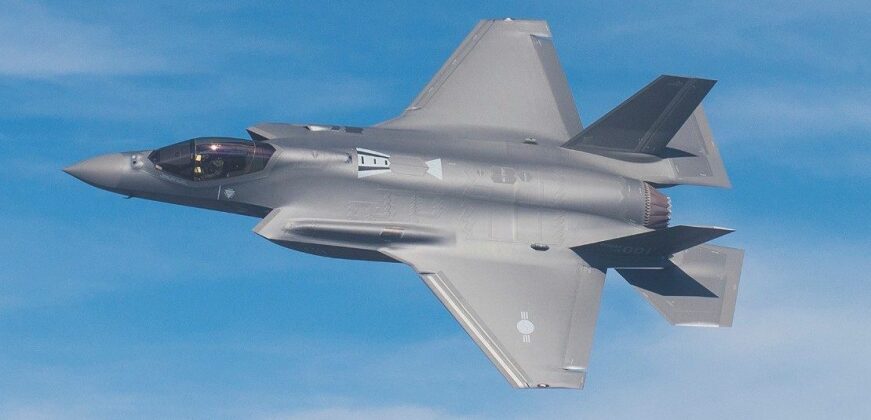News
Software Glitch Caused F-35 Crash Over Utah: How Performance Issues Continue to Put Lives in Danger
A U.S. Air Force F-35A fifth generation fighter which was destroyed in an accident at Hill Air Force Base in Utah on October 19, 2022 has been revealed by an Air Force investigation to have crashed due to a software issue. The aircraft from the 421st Fighter Squadron had been approaching the base in a formation of four F-35s a little after 6pm, before the pilot felt a “slight rumbling” of turbulence in the wake of the fighter in front of him which caused his aircraft’s flight controls to register incorrect flight data. His F-35 subsequently stopped responding to his attempts at manual control, instead sharply banking to the left and and ignoring his efforts to abort the landing sequence. An F-35 test pilot who witnessed the incident from the ground told investigators that the aircraft “looked like a totally normal F-35 before obviously going out of control…. I did see really large flight control surface movements — [stabilisers], trailing edge flaps, rudders all seem to be moving pretty rapidly.” Released on July 27, the report’s findings are expected to be used to avoid similar occupancies in the F-35 fleet. The fighter class continues to suffer from close to 800 performance bugs with new ones continuing to be discovered.

At times described as a “flying computer,” F-35’s complexity which caused the October 2022 crash has drawn significant criticisms from a wide range of sources, as despite providing several advantages its operations can be much more problematic than fighters from previous generations with more traditional avionics such as the F-16. An interview with an F-35 pilot conducted by American aviation magazine Hush Kit, for example, showed that many have struggled with the fighter’s interfaces and cockpit displays. The pilot observed at the time: “At present I am pressing the wrong part of the screen about 20 [percent] of the time in flight due to either mis-identification, or more commonly by my finger getting jostled around in turbulence or under G. One of the biggest drawbacks is that you can’t brace your hand against anything whilst typing—think how much easier it is to type on a smartphone with your thumbs versus trying to stab at a virtual keyboard on a large tablet with just your index finger.”
Difficulties using a touch screen system can reduce pilot’s reaction times and potentially cause serious dangers in combat. The pilot further observed that the F-35’s interface was the $400,000 ‘magic helmet,’ which replaced the heads up displays used on older aircraft such as the F-22 and F-16, could not show information as widely and instead shrank it to fit the helmet’s field of view. He further criticised its voice recognition system stating: “Voice input is another feature of the jet, but not one I have found to be useful. It may work well on the ground in a test rig, but under G in flight it’s not something I have found to work consistently enough to rely on. I haven’t met anyone who uses it.” His account was one of several similarly pointing to widespread dissatisfaction with what appeared to be excessively high tech features on the aircraft that actually hindered operational effectiveness. An inability to restore manual control of the aircraft on October 19, 2022, was but one such example.

As part of by far the most expensive weapons program in history the F-35 has frequently been described as too big to fail, with hundreds of billions of dollars already sunk into the program. The aircraft is irreplaceable due to its status as the only post fourth generation fighter in production in the Western world, and the only one capable of fighting on a similar level to the Chinese J-20 that is being produced in very considerable numbers and in increasingly advanced variants. Issues with the F-35 have nevertheless been extremely widespread, with problematic software most recently causing cuts to over one third of all production for 2023, while issues with the problematic F135 engine alone have cost the Pentagon $38 billion of dollars in unexpected maintenance expenses. Causing fighter unavailability at six times the rates of other fighters, the engine faced scathing criticisms from the House Armed Service Subcommittee on Readiness Chairman Congressman John Garamendi in May 2022, when he slammed the suggestion that the F-35 switch to reliance on a different engine from another producer saying it would likely result in two different engines that both “don’t work.” “Maybe the engine is not working, which is a Pratt & Whitney problem,” he said. “They’re going to be before this committee soon. If they’re in the audience and if they’re listening, watch out. I’m coming at you in a very angry mood. You give us an engine and it doesn’t work, well it worked for a little while until it gets some dust around and then it doesn’t work. What the hell? What’s going on here?”
The F-35’s performance has been very widely criticised by both military and civilian officials, as well as in reports from foreign operators such as South Korea, with its very low availability rates and lack of reliability taking a serious toll on the operational readiness of fleets that are widely adopting the aircraft. While problems with the program have resulted in tremendous expenses in peacetime, in wartime they have the potential to seriously influence the balance of power in the air in favour of future adversaries and thus put further lives at risk. Engine issues alone, which ground aircraft at far greater rates than the powerplants of other fighter classes, only make bases hosting the F-35 more ludicrous targets for adversaries heavily invested in assets such as ballistic missiles to counter the aircraft.












